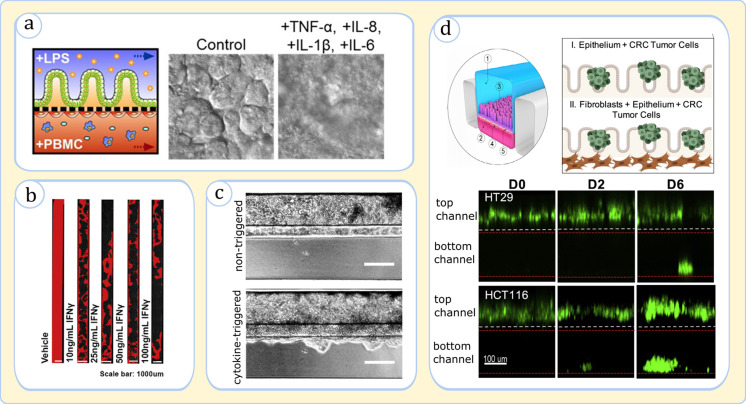FIG. 8.
Gut-on-a-chip systems for modeling of GI diseases. (a), (b), and (c) The simulation of IBD-related scenarios, and (d) the simulation of colorectal cancer (CRC). (a) (Left) Sketch of various cells interacting in the investigated gut chip: LPS: lipopolysaccharide; (middle and right) the simultaneous exposure to LPS and PBMCs induces epithelial cells to secrete a mixture of cytokines. Images (top-view) demonstrate that the treatment of the epithelium with a particular combination of cytokines causes physical injury. Adapted with permission from Kim et al., Proc. Natl. Acad. Sci. U. S. A. 113(1), E7 (2016).94 (b) The decrease in epithelium confluency (DAPI-stained: red) upon the addition of IFN-γ seen across the gut chip microchannel (top-view). Adapted with permission from Apostolou et al., Cell. Mol. Gastroenterol. Hepatol. 12(5), 1719 (2021). Copyright 2021 Elsevier.110 (c) Subjecting the epithelium to a cytokine cocktail, IL-1β, TNF-α, and IFN-γ, for a prolonged duration (11 days) causes the invasion of the epithelium to the neighboring ECM gel (side-view). Adapted with permission from Beaurivage et al., Int. J. Mol. Sci. 20(22), 5661 (2019). Copyright 2019 Authors, licensed under a Creative Commons Attribution (CC BY) license.120 (d) The invasion of tumor cells HT29 and HCT116 from the top channel (lumen) into the bottom channel (vascular) across the epithelial and endothelial cells (side-view). Adapted with permission from Strelez et al., iScience, 24(5), 102509 (2021). Copyright 2021 Elsevier.121

